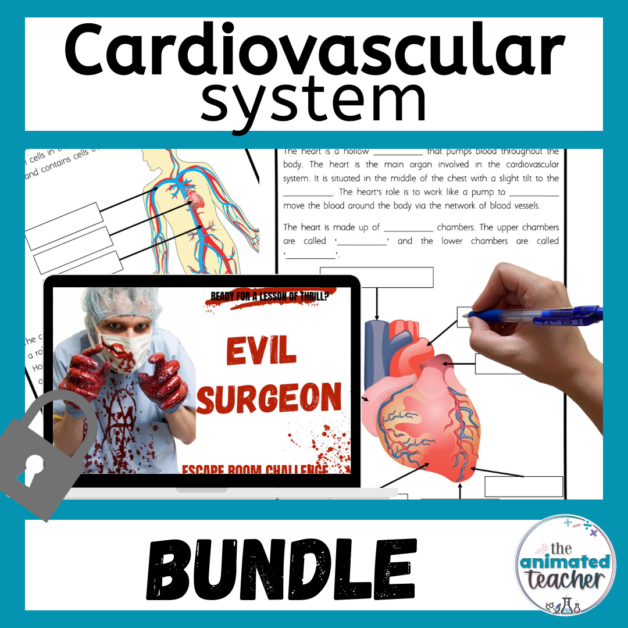73 Fun Human Body Systems Activities and Ideas
Middle and high school is a crucial time for students to delve into the fascinating world of human biology and human body systems. Understanding the intricacies of the human body systems can be a challenging but rewarding experience. To make learning engaging and enjoyable, educators can incorporate a variety of hands-on human body systems activities that cater to different learning styles.
In this blog post, we’ll explore 73 fun and interactive human body systems activities and ideas suitable for middle school students. From cut and paste activities to digital escape rooms, these activities are designed to foster curiosity and deepen understanding.
human body systems activities ideas

Disclaimer: This blog post, ‘73 fun human body systems activities and ideas’, may contain links to resources that I have created for classroom use. Read full disclaimer here. activ
In middle school the main individual body systems students need to know include:
- The digestive system
- The respiratory system
- The cardiovascular system
- The skeletal system
- The muscular system
- The nervous system
- The excretory system
- The male reproductive system
- The female reproductive system
- The immune system
There is a lot to learn in these categories once you take into account the many body parts, functions, major systems, how the systems interact with each other, and the many processes that occur in the human body to keep it alive and well.
Engage students in learning with the following human body systems activities and ideas.
human body systems activities ideas
73 Fun Human Body Systems Activities for Middle School
No-prep Human Body Systems Activities
While the below categories are great to explore, I’m going to start but mentioning my favorite no-prep or print-and-go human body systems activities first.
Why?
If I have to explain it you’re probably not a teacher!
- Organ Diagram Labelling:
Offer diagrams of specific body systems and have students label the organs using a word bank. This activity enhances anatomical knowledge and helps reinforce the connections between organs. Grab a free copy of my diagram labelling for the heart.
- Human Body Systems Stations:
Set up stations around the classroom, each dedicated to a different body system. Students rotate through these stations, engaging in activities related to each system. This approach provides a comprehensive overview of the human body. Grab some ready to print and go here.
- Human Body Systems Crossword Puzzles:
Create crossword puzzles with clues related to different body systems. This activity not only reinforces terminology but also encourages critical thinking and problem-solving skills. Grab a bundle of body system crossword puzzles here.
- Escape Room Challenges:
Design or use a pre-made digital escape room with puzzles and challenges related to human body systems. Students must solve each puzzle to “escape,” promoting teamwork and critical thinking. These are perfect to do individually or in small groups to engage students and a great way to promote class discussion and collaboration. See my favorite body system digital escape rooms here.
- Scaffolded notes
Scaffolded notes or cloze passages are a great way to help students learn in a supportive way and to ensure they all have a full set of notes to revise over later.
6. Doodle Notes
Encourage students to complete pre-made doodle notes or to create doodle notes illustrating processes like digestion, respiration, or the circulatory system. The act of visually representing processes helps with memory retention, and the creative aspect makes learning more enjoyable. Grab a FREE copy of my cardiovascular doodle notes to see if you like them!
Note: “Doodle Notes” is a trademarked term used with permission. Please visit doodlenotes.org for more information.
Creative Human Body Systems Activities
- Human Body Systems Podcasts:
Assign students the task of creating podcasts discussing different body systems. This activity enhances communication skills and allows students to become teachers themselves. Even just listening to some cool podcasts would be a great addition to the classroom.
- Build-a-Body:
Provide students with templates of the human body and various organs. Students can cut and paste the organs onto the body template, creating a visual representation of the human body.
- DIY Model Organs:
Encourage creativity by having students create three-dimensional models of organs using household items like clay, playdough, or recycled materials. This hands-on approach allows for a deeper understanding of organ structure.
- Anatomy Coloring Pages:
Provide intricate coloring pages featuring anatomical illustrations. This artistic approach not only relaxes students but also reinforces their understanding of organ placement and structure.
- Body Systems Comic Strips:
Encourage creativity by having students create comic strips illustrating the interactions between different body systems. This artistic approach combines science with storytelling.
- DIY Organ T-Shirts:
Bring creativity into the classroom by having students design T-shirts featuring different organs. This artistic activity allows for personal expression while reinforcing knowledge of organ locations.
- Systems Songwriting:
Challenge students to write and perform songs about various body systems. This musical approach makes learning memorable and enjoyable.
- Bio-Art Gallery:
Host a bio-art gallery where students showcase their artistic representations of different body systems. This interdisciplinary approach combines science with the arts.
- Anatomy Rap Battles:
Organize rap battles where students create rhymes and verses related to different body systems. This musical approach combines creativity with scientific knowledge.
- Human Body Systems Diorama:
Assign students the task of creating dioramas representing different body systems. This three-dimensional approach reinforces spatial understanding.
human body systems activities ideas
-
Sale!

Body Systems Escape Room Digital Bundle
Original price was: $34.93.$27.93Current price is: $27.93. -
Sale!

Body Systems Worksheets, Stations and Activities Bundle
Original price was: $47.93.$38.33Current price is: $38.33. -
Sale!

Body Systems Activities Ultimate Mega Bundle
Original price was: $92.46.$60.05Current price is: $60.05.
Technology Human Body Systems Activities
- Virtual Dissection:
Explore online resources that offer virtual dissection experiences. These interactive simulations allow students to virtually dissect organs and gain a better understanding of their structures and functions. Click here to see 15 virtual dissection labs.
- Interactive Apps:
Explore educational apps that allow students to interact with 3D models of the human body. These apps often include quizzes and challenges to reinforce learning.
- Digital Interactive Notebooks:
Utilize digital platforms for interactive notebooks where students can compile information, images, and videos related to each body system. This method enhances digital literacy while organizing information.
- Body Systems QR Code Trail:
Develop a QR code trail around the school or classroom, with each code leading to information or a challenge related to a specific body system.
- Virtual Reality Field Trip:
Explore virtual reality resources that offer immersive experiences inside the human body. This technology provides a unique perspective and enhances spatial understanding.
- Interactive Worksheets:
Design worksheets with interactive elements such as drag-and-drop features, clickable links, and multimedia integration to engage students in an online environment.
23. Disease Simulations:
Simulations depicting the impact of diseases on specific body systems allow students to witness the consequences of diseases on organs and systems, gaining a deeper understanding of pathology.
human body systems activities ideas
Video Human Body Systems Activities
Incorporating video lessons into the curriculum adds a dynamic visual element, catering to various learning styles. These videos can range from animated explanations to real-life dissections, bringing the subject matter to life.
24. Virtual Tours of Organs:
Utilize virtual tours or 3D animations to explore the structures of organs like the heart, lungs, and brain. This visual experience enhances understanding and retention.
25. Documentary on Body Systems:
Show documentaries that provide a comprehensive overview of the human body systems. Discuss the real-world applications of the knowledge gained from studying these systems.
26. Interviews with Experts:
Feature interviews with healthcare professionals, scientists, or researchers discussing their work related to human body systems. This provides insights into the practical applications of the knowledge being taught.
27. Historical Perspectives:
Explore the historical development of our understanding of human anatomy and physiology. Discuss key discoveries and the scientists who played pivotal roles.
28. Animated Cell Processes Videos: Watch animations illustrating cellular processes.
29. Virtual Reality Body Systems Exploration: Use virtual reality for an immersive exploration.
30. Biographical Videos on Scientists: Learn about scientists who contributed to anatomy.
31. Live Dissection Demonstrations: Stream live dissection demonstrations for real-time learning.
32. Digital Microscope Exploration: Explore microscopic structures using digital microscopes.
33. Virtual Field Trip to Medical Facilities: Virtually visit hospitals or labs to see medical practices.
34. TED-Ed Talks: Watch TED-Ed talks explaining biological concepts related to human body systems.
35. Interactive 3D Anatomy Videos: Explore interactive 3D videos illustrating anatomy.
36. Human Body Systems Webinars: Attend webinars led by experts in the field.
37. Online Courses on Human Anatomy: Enroll in online courses for in-depth learning.
38. Scientific Experiments Videos: Watch videos of scientific experiments related to body systems.
39. Virtual Exploration of Medical Imaging: Explore medical imaging techniques virtually.
40. Biomechanics in Sports Videos: Understand the role of body systems in sports biomechanics.
41. Time-Lapse Videos of Cellular Processes: Observe time-lapse videos of cellular activities.
42. Historical Anatomy Documentaries: Dive into documentaries exploring the history of anatomy.
Research Human Body Systems Activities
43. Human Body Systems Timeline:
Challenge students to create a timeline showcasing the development of their understanding of human body systems. This activity fosters a sense of historical perspective and the evolution of scientific knowledge. This could also be done by researching the development of our understanding as technological advancements have led to an increase in our knowledge and understanding.
44. Body Systems Concept Maps:
Have students create concept maps illustrating the connections between various body systems. This visual representation helps them see the bigger picture and understand the interdependence of systems. Another fun modification of this is setting up the different body systems around the classroom, then using string to draw connections between those that interact together. This creates a great web and demonstrates the complexities of the human body.
45. Human Body Systems Trading Cards:
Encourage students to create trading cards featuring different body systems. This activity combines research and creativity, and students can trade cards to reinforce learning.
46. Case Studies:
Present real-life case studies involving issues within specific body systems. Students analyze the cases, propose solutions, and discuss the implications.
47. Body Systems Debate:
Organize debates where students argue for or against specific practices or technologies related to human body systems. This activity develops critical thinking and argumentation skills.
human body systems activities ideas
Hands-on & Experiments Human Body Systems Activities
Engaging students in hands-on experiments is a powerful way to deepen their understanding of human body systems. These experiments not only provide practical experience but also foster critical thinking and problem-solving skills. Here are a few examples:
48. Heart Rate Investigation:
Students explore the relationship between physical activity and heart rate.
Have students measure their resting heart rate, perform various exercises, and record how their heart rate changes. Discuss the impact of exercise on the cardiovascular system.
49. Digestive System Model:
Students create a model of the digestive system using household items. Students can simulate the journey of food through the digestive tract, emphasizing the role of enzymes and organs.
50. Lung Capacity Test:
Students explore the respiratory system function by measuring their lung capacity using simple experiments like a balloon and straw test. Discuss the importance of lung capacity in the respiratory system.
51. Sensory Perception Challenge:
Blindfold students and have them rely on other senses to identify objects.
Discuss how the brain processes sensory information and the role of the nervous system in perception.
52. Reflex Arc Test
Students test how fast their reflex arc is by dropping a ruler and seeing at what distance a peer was able to catch it. Grab a copy of this with full notes here.
53. Sensory Perception Challenge: Explore sensory perception by relying on non-visual senses.
54. Cellular Respiration Experiment: Demonstrate the process of cellular respiration using simple materials.
55. Blood Typing Activity: Simulate blood typing using safe, household items.
56. Muscle Contraction Demonstration: Explore muscle contractions using rubber bands or strings.
57. Circulatory System Pump Model: Build a model demonstrating how the heart pumps blood.
58. Kidney Filtration Experiment: Simulate kidney filtration using a simple filtration setup.
59. Interactive Brain Hemisphere Model: Create a hands-on model showcasing the functions of brain hemispheres.
60. Hormone Release Simulation: Demonstrate how hormones are released into the bloodstream.
61. Respiratory System Model: Build a model demonstrating the movement of air through the respiratory system.
62. Taste Bud Mapping: Explore taste bud locations on the tongue through tasting activities.
63. Endocrine System Hormone Relay: Simulate the relay of hormones through the endocrine system.
64. Joint Movement Demonstrations: Perform activities to understand the range of joint movements.
65. Skin Sensation Experiment: Investigate skin sensitivity using different stimulis
66. Visualizing Blood Flow: Use colored water to visualize blood flow through vessels.
67. Interactive Eye Model: Create a model demonstrating how the eye focuses on objects.
68. Simulated Immune Response: Explore the immune system’s response to invaders through a role-play.
69. Modeling Nerve Impulses: Use dominoes or other props to simulate nerve impulses.
70. Cut & paste activities: cut and paste to organise key term and definition, or body system and organ etc.
human body systems activities ideas
Fun Human Body Systems Activities
71. Body Systems Board Game:
Develop a board game where players navigate through the human body systems, answering questions and completing challenges to advance. This game format makes learning fun and competitive. To save you some preparation time, you could even get each student to write a question to enter into the board game rather than you creating them all yourself. Enter your email here and I’ll send you a free board game template!
72. Human Body Systems Jeopardy:
Create a Jeopardy-style game with questions related to various body systems. Students can compete individually or in teams, testing their knowledge in a fun and interactive way.
73. Human Body Systems Scavenger Hunt:
Create a scavenger hunt where students search for clues related to different body systems. This activity promotes teamwork and problem-solving skills.
human body systems activities ideas
Conclusion
Incorporating these diverse approaches—science experiments, video lessons, interactive simulations, and graphic organizers—ensures that educators cater to different learning needs, making the study of human body systems not only educational but also enjoyable and memorable for middle school students.
By making science fun and engaging, educators can inspire a lifelong curiosity about the wonders of the human body.
Comment below with your favorite ways to teach students about the human body systems including your best human body activities.
Note: Always consult your school’s specific safety guidelines and policies, and seek guidance from experienced colleagues or administrators when in doubt about safety protocols. 40 fun candy science experiments
About the Author

Katrina Harte is a multi-award winning educator from Sydney, Australia who specialises in creating resources that support teachers and engage students.
human body systems activities ideas










